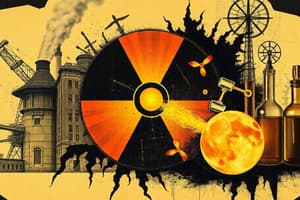Podcast
Questions and Answers
What type of nuclear reaction involves a heavy nucleus splitting into two or more lighter nuclei?
What type of nuclear reaction involves a heavy nucleus splitting into two or more lighter nuclei?
- Nuclear fusion
- Radioactive decay
- Fission (correct)
- Alpha decay
Define half-life in relation to radioactive atoms.
Define half-life in relation to radioactive atoms.
Half-life is the time it takes for half of the radioactive atoms in a sample to decay.
After one half-life, _____ of the original sample remains.
After one half-life, _____ of the original sample remains.
half
Radioactive decay is a random process where unstable nuclei emit energy to become less stable.
Radioactive decay is a random process where unstable nuclei emit energy to become less stable.
Which type of radiation has enough energy to remove tightly bound electrons from atoms, causing ionization?
Which type of radiation has enough energy to remove tightly bound electrons from atoms, causing ionization?
Flashcards are hidden until you start studying
Study Notes
Nuclear Reactions
- A nuclear reaction is a process in which atomic nuclei interact, resulting in a change to the nucleus
- Types of nuclear reactions:
- Nuclear fission: a heavy nucleus splits into two or more lighter nuclei
- Nuclear fusion: two or more light nuclei combine to form a heavier nucleus
- Radioactive decay: a nucleus emits radiation to become more stable
Half-life
- Half-life (t1/2) is the time it takes for half of the radioactive atoms in a sample to decay
- Half-life is a constant for a given radioactive substance
- Half-life can range from fractions of a second to billions of years
- After one half-life, half of the original sample remains
- After two half-lives, one-quarter of the original sample remains
- After three half-lives, one-eighth of the original sample remains, and so on
Radioactive Decay
- Radioactive decay is a random process in which unstable nuclei release energy and particles to become more stable
- Decay modes:
- Alpha decay: emission of an alpha particle (2 protons and 2 neutrons)
- Beta decay: emission of a beta particle (electron or positron)
- Gamma decay: emission of gamma radiation (high-energy photons)
- Radioactive decay is a first-order process, meaning the rate of decay is proportional to the number of radioactive atoms present
Types Of Radiation
- Ionizing radiation: radiation with enough energy to remove tightly bound electrons from atoms, resulting in ionization
- Alpha particles
- Beta particles
- Gamma rays
- X-rays
- Non-ionizing radiation: radiation without enough energy to remove tightly bound electrons from atoms
- Radio waves
- Microwaves
- Infrared light
- Visible light
Ionizing Radiation
- Ionizing radiation can cause harm to living organisms by damaging DNA and other biological molecules
- Effects of ionizing radiation:
- Genetic mutations
- Cancer
- Radiation sickness
- Cell death
- Units of ionizing radiation:
- Becquerel (Bq): one disintegration per second
- Gray (Gy): absorbed dose of ionizing radiation
- Sievert (Sv): biological effect of ionizing radiation
Nuclear Reactions
- Atomic nuclei interact, resulting in a change to the nucleus
- Nuclear fission: heavy nucleus splits into two or more lighter nuclei
- Nuclear fusion: two or more light nuclei combine to form a heavier nucleus
- Radioactive decay: nucleus emits radiation to become more stable
Half-life
- Time it takes for half of the radioactive atoms in a sample to decay
- Constant for a given radioactive substance
- Ranges from fractions of a second to billions of years
- After one half-life, half of the original sample remains
- After two half-lives, one-quarter of the original sample remains
- After three half-lives, one-eighth of the original sample remains, and so on
Radioactive Decay
- Random process: unstable nuclei release energy and particles to become more stable
- Decay modes: alpha, beta, and gamma decay
- Alpha decay: emission of an alpha particle (2 protons and 2 neutrons)
- Beta decay: emission of a beta particle (electron or positron)
- Gamma decay: emission of gamma radiation (high-energy photons)
- First-order process: rate of decay is proportional to the number of radioactive atoms present
Types Of Radiation
- Ionizing radiation: enough energy to remove tightly bound electrons from atoms, resulting in ionization
- Alpha particles, beta particles, gamma rays, and X-rays are ionizing radiation
- Non-ionizing radiation: without enough energy to remove tightly bound electrons from atoms
- Radio waves, microwaves, infrared light, and visible light are non-ionizing radiation
Ionizing Radiation
- Causes harm to living organisms by damaging DNA and other biological molecules
- Effects: genetic mutations, cancer, radiation sickness, and cell death
- Units of ionizing radiation: Becquerel (Bq), Gray (Gy), and Sievert (Sv)
- Becquerel (Bq): one disintegration per second
- Gray (Gy): absorbed dose of ionizing radiation
- Sievert (Sv): biological effect of ionizing radiation
Studying That Suits You
Use AI to generate personalized quizzes and flashcards to suit your learning preferences.




